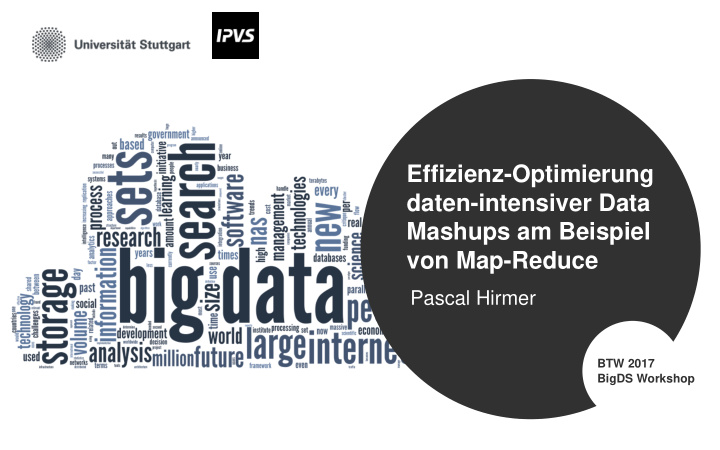



Effizienz-Optimierung daten-intensiver Data Mashups am Beispiel von Map-Reduce Pascal Hirmer BTW 2017 BigDS Workshop
Towards optimizing the efficiency of data- intensive data mashups based on the example of Map-Reduce Pascal Hirmer BTW 2017 BigDS Workshop
Motivation Big Data • Big Data: volume and complexity of data highly increases • New paradigms: Internet of Things, Industrie 4.0, Data Lakes, … • It is important to gain knowledge through data processing and analysis (knowledge discovery) • But: gaining knowledge is difficult because of the (at least) three Vs of Big Data: • Volume • Variety • Velocity 3
Data Mashups - Definition • Goal: flow-based processing, analytics, and integration of data • Modeling of data operations based on Pipes and Filters extract filter join analyze extract • Famous example: Yahoo! Pipes 4
Motivation Data Processing Tools • Data Mashup tools, ETL tools, and data analytics tools (e.g. KNIME) offer means to process and analyze data • Focus on approaches that support abstract modeling based on the pipes and filters pattern • nodes: data operations (e.g., extraction, transformation, analysis) • edges: data flow • nodes are associated with services that process the data (orchestrated by workflows) • Offer an explorative means to process data • Focus lies on the Open Source Data Mashup Tool FlexMash developed at the Uni Stuttgart • Concepts are also applicable to different approaches for data processing 5
Motivation • Overall goal of this work: Increasing the efficiency of service-based data processing • State of the art: data processing "in-service" (memory) scalability / memory issues S1 S2 S4 S5 S3 • Approach in a nutshell: • Move data processing on computing clusters and process data in parallel • Integration of modern data processing techniques and technologies (Map-Reduce, Apache Spark, …) • Coping with the generated overhead (where is the cost-value limit?) 6
FlexMash Cloud-based execution Mashup Execution Environments Robust Time-Critical FlexMash Secure ? Modeling Tool Robust & Mashup Pattern Mashup Secure Result Mashup Plan Selection & Modeler Combination … Pattern-based Domain-specific Pattern Transformation and Visualization Modeling Selection Execution 7
FlexMash – Graphical User Interface Download FlexMash on Github: https://github.com/hirm erpl/FlexMash 8
Main contribution (I) Mashup Plan (non-executable) Executable representation of the data flow model extract analyze filter join Service runtime in-service parallel data processing Parallel data processing based on computing clusters 9
Main contribution – decision: in-service vs. distributed/parallel Requirements (e.g., costs) Transformation executable model Mashup Plan (non-executable) Service Repository Services Policies/Capabilities 10
Conclusion and future work • First approach to increase the efficiency of service-based data processing tools • Large efficiency advantages enabled through parallelization • Finding the cost-value limit is difficult • Future/ongoing work • Conducting measurements for comparison and finding cost-value limit • Concretizing the concepts • Generation of Map-Reduce jobs 11
Questions & Discussion ? 12
Thank you! Pascal Hirmer E-Mail Pascal Hirmer@ipvs.uni-stuttgart.de Telefon +49 (0) 711 685- 88297 Fax +49 (0) 711 685- 78217 Universität Stuttgart Pascal.Hirmer@ipvs.uni-stuttgart.de Universitätsstraße 38, 70569 Stuttgart, Germany
Recommend
More recommend